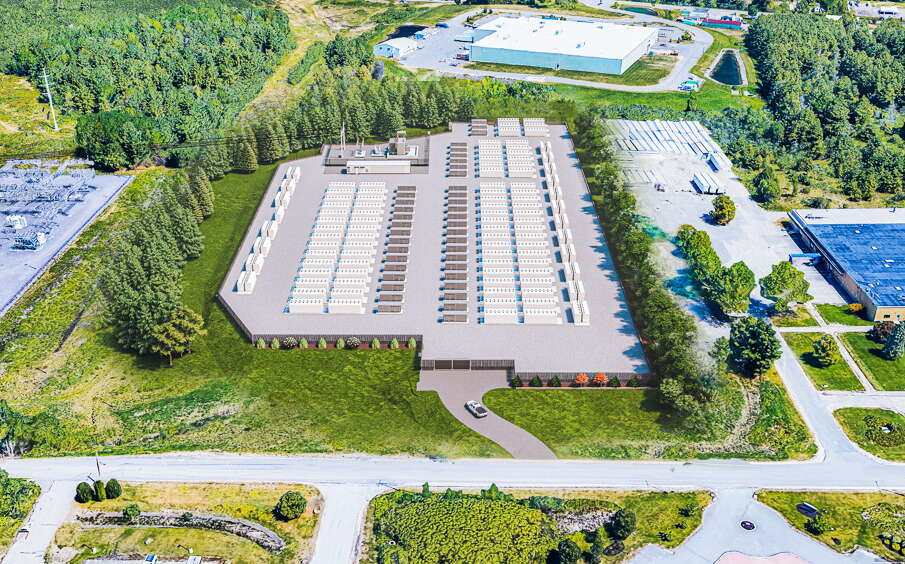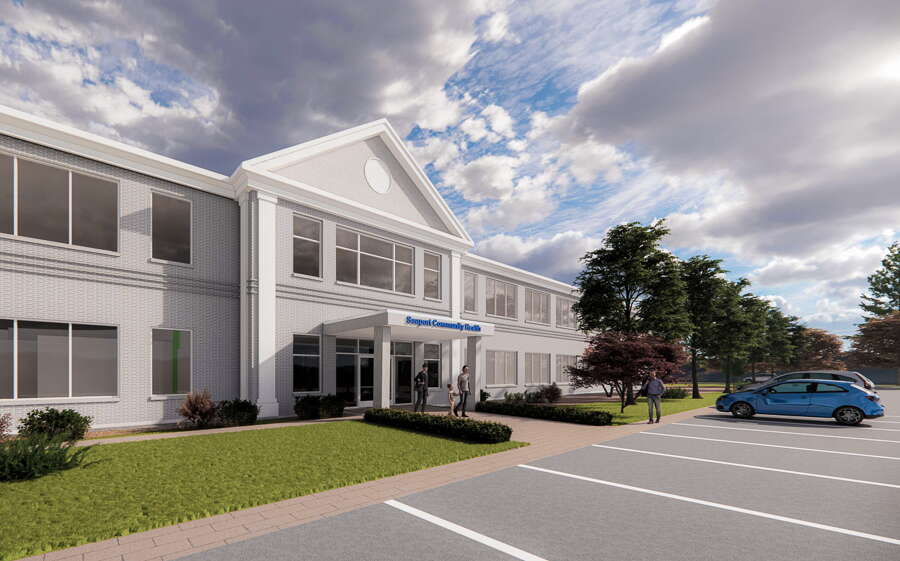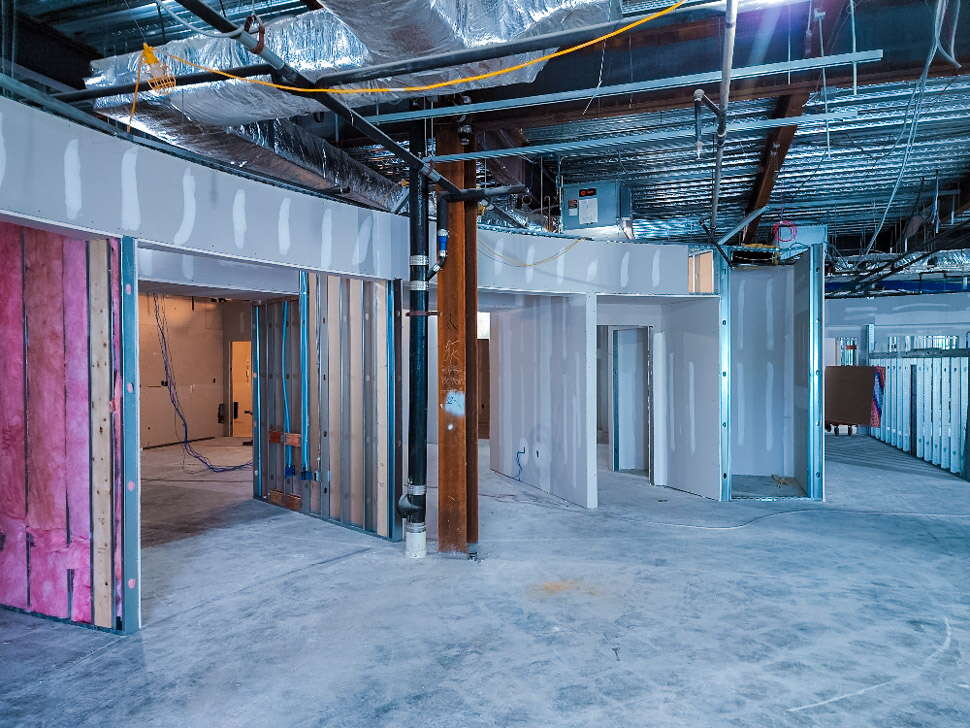
Processing Your Payment
Please do not leave this page until complete. This can take a few moments.
New builds: A range of construction projects are in the pipeline
 Photo / Fred Field
Ed Karpinski, right, of the Maine Department of Transportation and John Kelly of Acadia National Park say the Acadia Gateway Center will provide a ‘sense of arrival’ to visitor attractions.
Photo / Fred Field
Ed Karpinski, right, of the Maine Department of Transportation and John Kelly of Acadia National Park say the Acadia Gateway Center will provide a ‘sense of arrival’ to visitor attractions.
Maine has a number of interesting construction projects underway, serving every industry from health care to tourism to renewable energy.
Projects cover the gamut throughout the pipeline and include mixed-use and residential development, Roux Institute’s plans to build a campus at the former manufacturing facility for B&M Baked Beans in Portland, and planned renovations and upgrades at the University of Maine’s Harold Alfond Sports Arena and Shawn Walsh Hockey Center.
Welcoming visitors
In the Hancock County town of Trenton, folks driving along Route 3 between Ellsworth and Mount Desert Island will notice a long-awaited sight — the start of construction on the Acadia Gateway Center.
“All the timber framing is up for the new building,” says Ed Karpinski, resident engineer on the project for the Maine Department of Transportation.
The $27.7 million transit hub and welcome center were a long time coming.
It’s the second phase of a plan first enshrined in a memorandum of understanding among 20 partners in 1999. The first phase, completed in 2012, included the construction of a park-and-ride lot as well as office space and a bus maintenance facility for Downeast Transportation, which operates the Island Explorer, a free shuttle serving Acadia National Park and Mount Desert Island. That facility is tucked back out of sight from Route 3.
A long time coming
In 2002, Friends of Acadia began planning phase two. It 2007, the nonprofit sold 152 acres fronting Route 3 to to MDOT, the project’s owner.
Last year, work ramped up with Brewer general contractor Nickerson & O’Day on the job.
The center is designed to serve as a location where visitors can access regional tourism information, buy park entrance passes and connect with transit options to help them explore the region car-free.

The project incorporates several sustainability features, including a geothermal heating and cooling system, a rooftop solar panel array and electric vehicle charging stations. Planners included MDOT, the Federal Transit Administration, the National Park Service, Friends of Acadia and Downeast Transportation.
The site sits between Ellsworth and Mount Desert Island; its location was designed to intercept traffic traveling south on Route 3 before arriving onto Mount Desert Island.
With 3.88 million visitors last year, Acadia ranked No. 7 among national parks, according to National Park Service numbers. In 2017, the annual average daily traffic count on Route 3 at the center’s location is almost 14,570 — and likely a lot higher on a sunny July day.
The project is funded by private and public support from Friends of Acadia, MDOT, the National Park Service and Federal Transit Administration.
In recent weeks, says Karpinski, wall and roof panels were going on and earthworks were underway, with much of the base pavement put down for the parking lot and construction in progress for a wet pond and a grass filter pond to accommodate storm water runoff. Coming up is systems installation and interior work.
A major benefit of the project, he says, is getting cars and RVs off the road. People can park at the center, visit the information center, then hop the Island Explorer to MDI and Acadia.
John Kelly, Acadia National Park’s management assistant, says the project pulls together a number of visitor-centered features that are otherwise somewhat dispersed, including transit options, park information and the ability to buy a park entrance pass.
“This is important for providing a sense of arrival to the park,” says Kelly. The goal is to complete construction in May 2025.
Utility-scale battery plant
In February, Plus Power broke ground in the Cumberland County town of Gorham on Maine’s largest transmission-connected battery storage facility.
Plus Power, based in Texas, develops, owns and operates utility-scale energy storage facilities, with the goal of enhancing grid stability by storing excess energy and injecting it back into the grid when it’s needed during record peaks, storms and unexpected demand.
The 175-megawatt battery storage project will provide energy and capacity services to the New England grid, with the goal of enhancing grid reliability and accelerating the integration of readily available renewable energy.
The Cross Town Energy Storage project is on roughly five acres in Gorham Industrial Park and adjacent to Central Maine Power’s 115-kilovolt Moshers substation.

The site was selected based on proximity to Moshers as a regional substation serving northern Maine to Boston.
“Through our studies, we identified that as a key substation in Maine that would benefit from our project,” says Mark Tourangeau, a Cumberland resident and Plus Power’s chief revenue officer, who is in charge of operating the project.
Utility-scale battery storage facilities are considered a relatively new tool for supporting the energy grid.
“It’s relatively new,” says Tourangeau. “But it’s being deployed worldwide and is shown to be very effective.”
According to Plus Power, grid decarbonization and extreme weather are adding stress to a power grid built for a bygone era. Standalone battery power plants, the company says, help to stabilize the grid and also accommodate energy produced by solar and wind power plants.
The company operates three projects in Hawaii and Texas and has developed two projects in Texas that are owned by others. Plus Power has six more projects in construction, including Cross Town.
Polly Shaw, Plus Power’s chief external relations officer, says the company was drawn to Maine by the state’s goals for decarbonization and sustainable energy.
In recent years, the state passed legislation that set goals for energy storage — 300 megawatts by the end of 2025 and 400 megawatts (nearly 20% of peak demand that year) by the end of 2030 — and directs steps to advance its deployment. The targets established Maine as the ninth state with codified energy storage targets.
The project will utilize 156 energy storage containers that consist of arrays of interconnected lithium-ion battery cells inside rectangular housing units that are about the size of a shipping container, along with integrated liquid-cooled HVAC systems with sophisticated sensors and controls to maintain climate conditions. Other components include inverters, a power transformer and underground cabling.
The systems are made by Sungrow Power Supply Co. Ltd., headquartered in Hefei, China.
The project is expected to employ just over 50 people, including apprentices, during construction and two to three people post-construction.
Lithium-ion batteries can be a safety hazard due to flammable electrolytes. Shaw and Tourangeau say that Plus Power follows national safety standards and codes specific to battery storage, works with a consultancy called the Energy Safety Response Group, brings in local fire departments for trainings, and has strict operating and mitigation procedures that include Central Maine Power and the grid operator, as well as local first responders and others.
Shaw Brothers, headquartered in Gorham, did the initial site work. Pittsfield-based Cianbro Corp. will build the facility to Plus Power’s engineering specifications and will stay on the job through testing and commissioning.
Construction is expected to start in May and the goal is to be commercially operational by mid-summer 2025.
The battery storage market is growing, says Tourangeau.
“We have a strong influx of wind and now solar,” he says. “The challenge is that those are intermittent. As we get to higher and higher levels of penetration of renewable resources, batteries become more important to store it and to discharge it. It’s that next piece that allows us to add more renewable energy onto the grid and help with the transition away from carbon-intensive resources.”
Health care investment
A bigger home for the Seaport Community Health Center is almost complete.

Building 5 in the former MBNA Bank of America complex at 21 Schoodic Drive, along Route 3 in the Waldo County city of Belfast, has been undergoing renovation and fit-up for the center, which is part of Penobscot Community Health Care.
The space will be more than double the size of Seaport’s lease at nearby 53 Schoodic Drive.
Earlier this year, Evernorth Rural Ventures, a subsidiary of Evernorth, closed an $8.9 million New Markets Tax Credit investment for the $9.6 million expansion.

Evernorth is a nonprofit based in Portland and Burlington, Vt., serving low- and moderate-income people of Maine, New Hampshire and Vermont with affordable housing and community investments.
Evernorth Rural Ventures is a rural community development entity that uses New Markets Tax Credit resources to support investment in the economic, environmental and social well-being of northern New England communities and regional economies.
The U.S. Treasury’s New Markets Tax Credit program is a financing tool that allows investors to provide capital and in return claim federal tax credits for a portion of their investment.
The credits offer a source of cheap or free equity developers wouldn’t otherwise have, allowing them to do projects that aren’t otherwise financially feasible. The financing package included Capital One as the NMTC equity investor to ERV, Primary Care Development Corp. and the federal Health Resources and Services Administration.
The Belfast project is ERV’s first investment in Maine. It’s expected the expanded facility will add 11 full-time positions and grow capacity by 17%.
“The increased space will allow us to significantly increase our integrated primary care services, inclusive of family medicine, mental health, recovery and pharmacy services, expanding the impact we are able to have in our community,” Lori Dwyer, Penobscot Community Health Care’s CEO and president, said earlier this year.
Penobscot Community Health Care is the largest federally qualified health center in Maine and the second-largest in New England.
The new facility is expected to open in the coming weeks. Dunbar & Brawn Construction is the general contractor.
Beth Boutin, ERV’s vice president, says ERV was attracted to the project as meeting its community investment mission.
“This is a perfect example of how New Markets Tax Credits can help communities in need,” says Boutin.














0 Comments